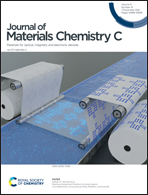The effects of the interstitial pores of buckypaper in trapping cobalt phthalocyanine and their use in sugarcane-extract fuel cells†
Abstract
A buckypaper (BP) and cobalt phthalocyanine (CoPc) composite anode (BP/CoPc) is suggested for alkaline sugarcane extract fuel cells (SCEFCs). With the use of the BP/CoPc catalyst, the amount of immobilized CoPc increases because many CoPc molecules are entrapped in the interstitial pores of the carbon nanotube (CNT) network, which is the main component of BP. As a result, the catalytic activity is improved. More specifically, CoPc loaded onto the CNT surface promotes the glucose oxidation reaction (GOR), showing a low onset potential (GOR-A), while CoPc placed in the interstitial pores of BP produces a high current density (GOR-B). In contrast, the sucrose oxidation reaction (SOR) shows only GOR-B-like behavior, demonstrating that the mass transfer of sucrose is sluggish. The open-circuit voltage and maximum power density of the fuel cells (FCs) using BP/CoPc are 0.93 ± 0.005 V and 17.6 ± 2.83 W m−2 with 0.5 M glucose, while they are 0.82 ± 0.008 V and 3.9 ± 0.23 W m−2 in FCs using sugarcane extract, respectively. These are significantly better than those of FCs using noble metal catalysts and microbial FCs. Additionally, BP/CoPc preserves 93.1% of its initial current density for 2 h, whereas that of conventional platinum black (Pt/C) drops to 22.5%, showing that BP/CoPc has strong resistance against poisoning.



 Please wait while we load your content...
Please wait while we load your content...